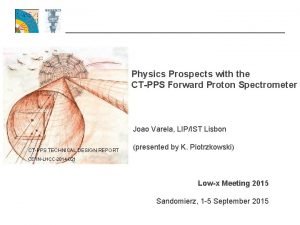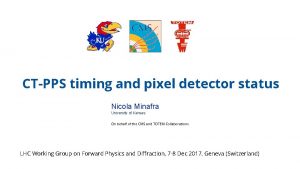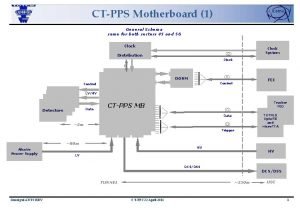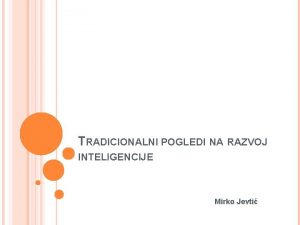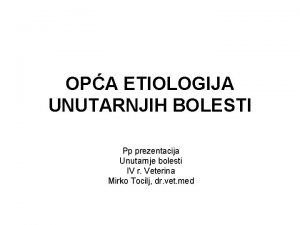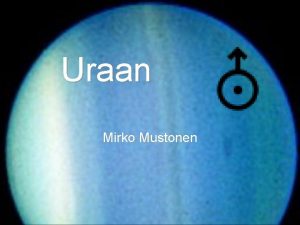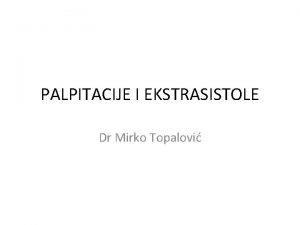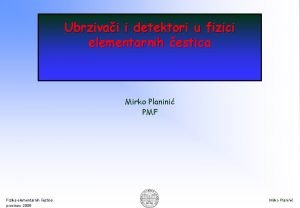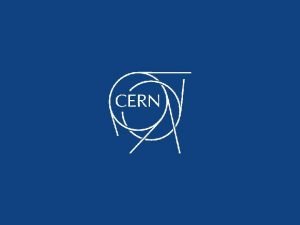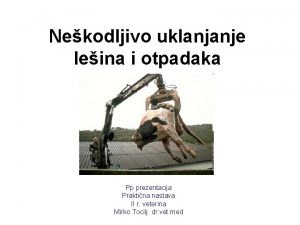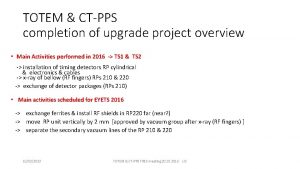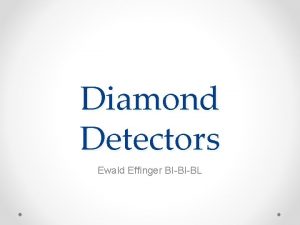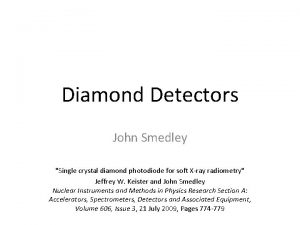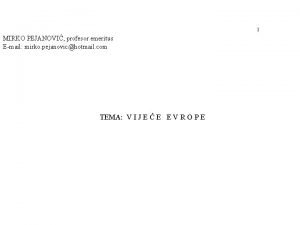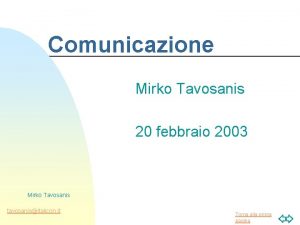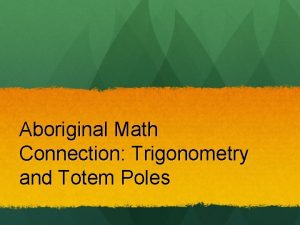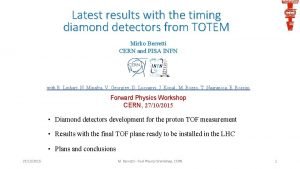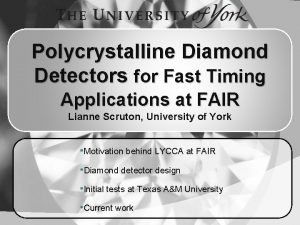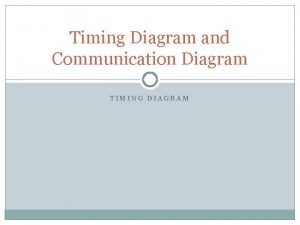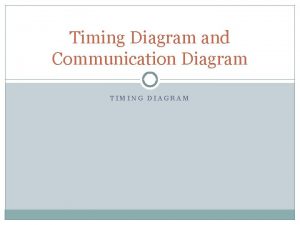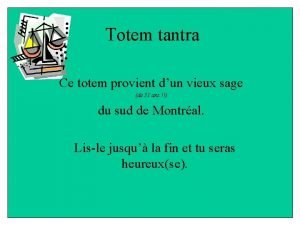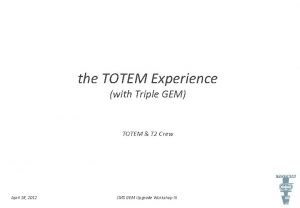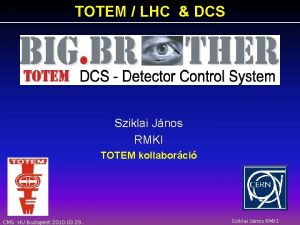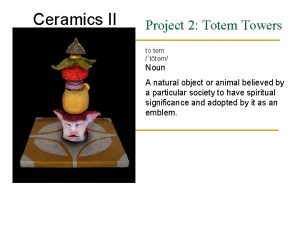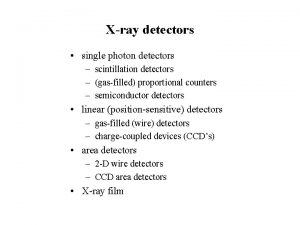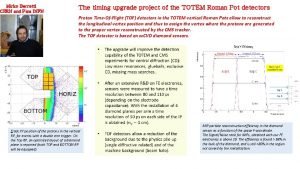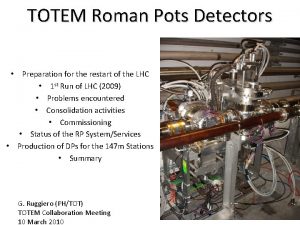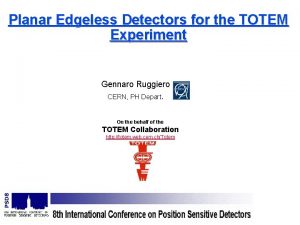Diamond timing detectors for TOTEM and CTPPS Mirko




























- Slides: 28

Diamond timing detectors for TOTEM and CT-PPS Mirko Berretti (R. Linhart, N. Minafra, M. Bozzo, E. Bossini, G. Antchev, V. Georgiev, T. Naaranoja, D. Lucsanyi, J. Baechler, N. Turini, D. Druzkin, I. Atanassov, A. Karev) LHC Working Group on Forward Physics and Diffraction CERN, 16/03/2016 • Installation in the LHC of TOTEM diamond detectors in the vertical RPs • Diamond detectors for CT-PPS: status and simulation studies 16 Mar 2016 M. Berretti, Forward Physics WG, CERN 1

Reminder: diamond detectors for timing in the RPs The TOTEM / CT-PPS upgrade programme focuses on improving the experiments capability to explore and measure new physics in Central Diffractive (CD) processes: p+p -> p + X + p. The installation of proton Time-Of-Flight (TOF) detectors in the TOTEM Roman Pots allows to reconstruct the longitudinal vertex position and thus to assign the proton vertex to the proper vertex reconstructed by the CMS tracker, in presence of event pileup. • • High b, m=1, 50 ps/arm, Rate/Pixel: 10 KHz. Low b, m= 30, 10 -30 ps/arm, Rate/Pixel: 1 MHz. 16 Mar 2016 M. Berretti, Forward Physics WG, CERN 2

Developments since the last October WG meeting: 1. Full test of diamonds detector in H 8 with secondary vacuum and cooling • The first tests in a secondary vacuum system were performed at T=-15 °C and P=30 mb. • We set higher T (with a compatible pressure) and we found that at T>10 °C the system behaves as expected in term of noise. RMS noise TB (m. V) § We found different working point/noise of the board § At 30 mb, we found discharge happening on the diamond board due to the HV. RMS noise Final config (m. V) • In summary: noise/gain performance are dependent only on T while discharge probability depends only on P (see the next slide) 16 Mar 2016 M. Berretti, Forward Physics WG, CERN 3

Maximum P-Voltage allowed • The most problematic thing was the HV ramp. The power supply, set at the maximum current limit of 1. 5 m. A (half of the value used in the TB) tripped already at about 450 V for standard values of secondary vacuum. • This discharges were found to damage the channels much more than the ones seen in standard P/T tests during previous TB. Empirical V max, defined as the maximum voltage at which overcurrent is observed (Imax=1. 5 m. A) 16 Mar 2016 M. Berretti, Forward Physics WG, CERN 4

Channel Numbering: Test beam results with P=170 mb and HV=(560. . 640) V • Pixel 3 was found to be aligned with the beam. Resolution measured with Oscilloscope and SAMPIC s=82 ps s=80 ps (SAMPIC) (oscilloscope) The time resolution was found to be better than in the previous TB at 700 V (enhanced S/N) Oct. TB (ps): (B 12, B 13, B 23) = (87, 92, 94) This Test (ps): (B 12, B 13, B 23) = (80, 90, 87) 16 Mar 2016 Pixel 1 multiplicity per event (trigger on Pixel 1) Compatible with misalignment 5

Tunnel installation (Nov. 2015) Thin window measurement with the laser s. L < 10 mm Closed 220 N Top! Insertion SAMPIC+ LAPTOP+ GSM data transfer (fiber as backup) Many thanks also to: R. Stefanovitch, A. Baud, X. Pons, L. Kottelat… 16 Mar 2016 M. Berretti, Forward Physics WG, CERN 6

Tunnel results • • • The system have been tested inside the tunnel at hybrid T=20 C and P=200 mb. The noise was found to be identical to the one measured in H 8. The T/P were stable for all the data taking period ~20 h. RP was in garage position, only showers arrived at a low rate <10 Hz. A more conservative current limit was set (0. 5 m. A), which allowed to ramp the system only up to 500 V. No extra dead channels (9 in total) was produced during the tunnel exercise. SAMPIC display, LHC shower Pix 3 B 1 -B 2 s=91 ps NB: 500 V DT (ns) 16 Mar 2016 M. Berretti, Forward Physics WG, CERN 7

HV tests of the hybrid in vacuum • First tests have been done by using the hybrid board without any diamond attached. 900 V, 50 mb (continuous discharges) • The systems, in P=50 mb, shown the first discharges at V=720 V. • By coating the HV distribution with Polyurethane the maximum voltage reached is 820 V. • The weak point of the board was found to be the diamond+ bonding (discharge started at about 450 V) 16 Mar 2016 M. Berretti, Forward Physics WG, CERN 8

TOTEM diamond detectors for CT-PPS • Big effort has been done in order to avoid discharge in secondary vacuum. • Diamond board tested down to 10 mb pressure and position of the eventual discharges and weak points were identified. • Action taken to achieve nominal HV (700 V) in secondary vacuum: • Redesign the board • Discharges on the board itself • Simulation of discharges: Old board gave discharges at ∼ 600 V (new design OK @ 900 V) • Coating and larger size wire bonding (weakest point) • Reduce the HV gluing pads not to have uncovered HV spots • Passivation of the uncovered spots • Kapton glued on top (done), special resins (done, to be tested), bigger bonding wires (done, to be tested) →The tests done with the Kapton on the old board gave good results, but quite complicated to be implemented. 16 Mar 2016 M. Berretti, Forward Physics WG, CERN HV pad 9

Horizontal board coating • PCB with special geometry for the horizontal RP and with better HV tolerance in vacuum already produced (population next 2 weeks) Diamond HV pads with reduced sizes • First tests seems that the problem has been fixed (up to 840 V at 60 mb) • NB: for tracking diamonds can be operated at ∼ 400 V → NO PROBLEM 16 Mar 2016 M. Berretti, Forward Physics WG, CERN • One old board was sent to a company for coating and large wire bonding: better for field reduction and reduced impedance for the signal • Silicon-based coating, RV=3· 1015 Wcm • 150 mm wire bonding 10

MIPOT board with coating and large wire arrived this morning. 16 Mar 2016 M. Berretti, Forward Physics WG, CERN 11

Diamond detectors for CT-PPS (1) Minimal mechanical/cooling adaptation needed: • Thin window profile adapted to the hybrid • Apart from this, champignon and cooling system is exactly the same of the vertical one 16 Mar 2016 M. Berretti, Forward Physics WG, CERN 12

Diamond detectors for CT-PPS (2) Biggest change: different digitizer • Unfortunately the Sampic cannot be used as we expect order of 3 MHz per channel (Sampic tested safely for 350 KHz/8 channels). Version 3 (not yet in production) can fix this problem by introducing a buffer for LS 1 selection. G. Antchev, Totem collaboration meeting • For the June installation, we will use the NINO+HPTDC, but the performance of this solution has to be verified. • The NINO board will be mounted externally as a mezzanine on the final digitizer board. 16 Mar 2016 M. Berretti, Forward Physics WG, CERN 13

Diamond geometry for CT-PPS: simulation results (1) • FPMC simulation (thanks to C. Royon) has been used to optimize the diamond geometry Ø It is enough one single diamond row (metallized width 4. 2 mm). Y left (mm) Proton Y-left vs Y-right for 2 g simulation at 13 Te. V and b=0. 8 m FPMC mass output Mass (Ge. V) Y right (mm) 16 Mar 2016 M. Berretti, Forward Physics WG, CERN 14

Diamond geometry for CT-PPS: patterns • Board for CT-PPS has been produced with 12 channels around a single raw in the X direction (4 diamonds): Occupancy simulation (including Physics and beam background, m=30) Y (mm) 4 diamonds/plane with this pattern (metallizations ongoing) Beam center BEAM CENTRE X (mm) • Due to the time constraint the patterns with (1, 2, 4)-strips from the diamonds in the vertical RPs have been also used. • The diamond closer to the beam has instead a new pattern with higher granularity, optimized for a low occupancy. 16 Mar 2016 M. Berretti, Forward Physics WG, CERN 15

Diamond detector mass reconstruction capability Generator mass – Reconstructed mass Possible to improve it by ∼ 30% by swapping the pixellization in one plane DM (Ge. V) 16 Mar 2016 M. Berretti, Forward Physics WG, CERN 16

2 g analysis and background reduction with the diamonds (1) • gg -> X(750 Ge. V) -> gg signal is generated with FPMC (assumed ∼ 4 -5 signals in acceptance in 25 fb-1) • Main background is given by inclusive gg+ proton pileup, s=230 fb-1 for Pt >50 Ge. V (http: //arxiv. org/pdf/1312. 5153. pdf) • Pileup has been simulated by Sherpa and pile-up protons from soft Phys. Beam back has been added BX event topology in the RP BX background mass probability ALL BX NO 2 -Arms Detector edge @ 15 s 2 -Arms Low Mult 2 -Arms High Mult • 2% (4%) of BX has a mass coincidence in the 700 -800 Ge. V region, assuming low (all) track multiplicity in the RP 16 Mar 2016 M. Berretti, Forward Physics WG, CERN 17

2 g analysis and background reduction with the diamonds (2) • Background can be also reduced by introducing a cut in the g energy, g PT balance and in the gg Df: • Data reduction and background suppression: To be confirmed according to the final LHC optics setting 16 Mar 2016 M. Berretti, Forward Physics WG, CERN 18

Radiation hardness 16 Mar 2016 M. Berretti, Forward Physics WG, CERN 19

Silicon radiation hardness • Looking at the 8 Te. V we see only few planes with strip shifted • No big shifts found in 13 Te. V data (but there diffractive peak very weak due to collimation set. ) • A shift of the plane/beam around the Y axis of about 0. 4 mm can do the job. 16 Mar 2016 M. Berretti, Forward Physics WG, CERN 20

Silicon radiation hardness 16 Mar 2016 M. Berretti, Forward Physics WG, CERN 21

Silicon radiation hardness • 28 days are needed to collect 20 fb-1 (6. 3 x 1013 BX) • Max number of BX in the hot spot was 2 x 1013 NEEDS ~3 detector packages in the worst case of fixed beam spot (NB: other solutions already found) 16 Mar 2016 M. Berretti, Forward Physics WG, CERN 22

Diamond radiation hardness: from William Trischuk (RD 42) sc. CVD: • @ 4 x 1015 p/cm 2 expected worsening of S/N of a factor 2 (still good efficiency) • At least factor 20 better than RP silicons 16 Mar 2016 M. Berretti, Forward Physics WG, CERN 23

Preparing for new planes production: Improved HV tests for diamond selection Test performed in Desy (Thanks to W. Lohman and M. Hempel) • Selection of High quality diamonds (leakage<10 p. A) at 1 k. V to be patterned. • Both leakage current and rate under source measured. 16 Mar 2016 M. Berretti, Forward Physics WG, CERN 24

Improved HV tests for diamond selection David and Tiina • Setup built also at CERN and Helsinki • We try to use spring probe instead of bonding to have a system ready to use at each arrival of the diamonds • Finalization of the system at CERN expected in 2 weeks • All diamonds for CT-PPS have been measured in terms of leakage current performance. 16 Mar 2016 M. Berretti, Forward Physics WG, CERN 25

Short term plan: • Enough diamonds are metallized (under metallization) to equip 2 cylindrical RPs in June with 4 planes/side • Intense work ongoing to be sure that the pressure/temperature problems are fixed • Almost continuous TOTEM/CT-PPS test beam ongoing from 25 April to TS 1, preparation of the experimental area • Production of the NINO+HPTDC+ digitized card and its interface ongoing/under testing (big effort/challenging) 16 Mar 2016 M. Berretti, Forward Physics WG, CERN 26

Conclusions: • Simulation studies show that very good background suppression can be achieved with standard RP tracking capability while diamonds can help due to the superior radiation hardness even with lower mass resolution. Spare silicon packages available from TOTEM in case of rad-hard will be an issue. Possible to cover the 20 fb 1 with 2/3 exchanges. Further studies are ongoing, beam or vertical detector movement of about 0. 5 mm would be enough. • New geometry for CT-PPS studied based on 2 g signal. Board produced and optimized for CT-PPS needs, diamonds/boards on schedule (even with tight margins for additional delays). • Final physics capability to be reviewed according to the final optics (dramatic dependence). 16 Mar 2016 M. Berretti, Forward Physics WG, CERN 27

Thanks 16 Mar 2016 M. Berretti, Forward Physics WG, CERN 28
 Ctpps
Ctpps University of kansas
University of kansas Motherboard schema
Motherboard schema Where are feature detectors located
Where are feature detectors located Kinesthesis and vestibular sense
Kinesthesis and vestibular sense Feature vectors
Feature vectors Feature detectors
Feature detectors Frontier detectors for frontier physics
Frontier detectors for frontier physics Yodsawalai chodpathumwan
Yodsawalai chodpathumwan Photo detectors
Photo detectors Streaming current detectors
Streaming current detectors Vhv voltage detectors
Vhv voltage detectors Photo detectors
Photo detectors Nuclear detectors
Nuclear detectors Chromatography mobile phase and stationary phase
Chromatography mobile phase and stationary phase Giant wave detectors murmurs universe
Giant wave detectors murmurs universe Giant gravitational detectors hear murmurs across
Giant gravitational detectors hear murmurs across Mirko jevtic
Mirko jevtic Mirko tocilj
Mirko tocilj Mirko tocilj
Mirko tocilj Mirko mustonen
Mirko mustonen Mirko topalovic 7
Mirko topalovic 7 Mirko odepemko
Mirko odepemko Mirko grljušić
Mirko grljušić Mirko planinić
Mirko planinić Content radar mirko lange
Content radar mirko lange Mirko pojer
Mirko pojer Mirko pojer
Mirko pojer Mirko tocilj
Mirko tocilj
